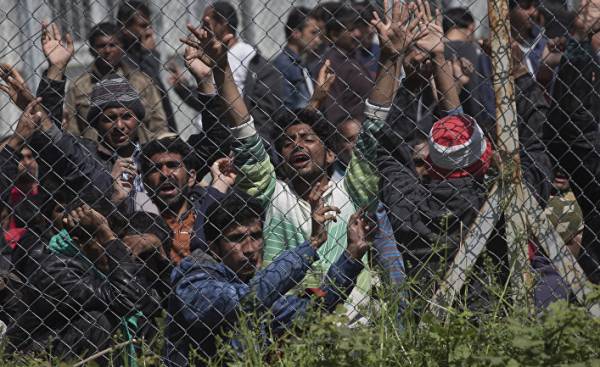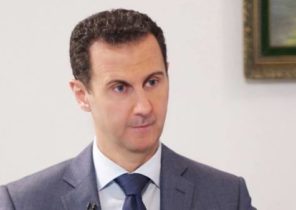
The crisis of refugees and migrants, which has become a profound shock to the cooperation within the framework of the EU — only the beginning of an ever-growing and never-ending migratory pressures on the European continent.
We are talking about the historical challenges, responses to which cannot be given immediately by making changes in the current practice of granting asylum. They will require a complete paradigm shift. If the EU will not be able to reform itself, it will have serious consequences for security, cooperation and stability in Europe.
Just last year, approximately 181.000 migrants went on a dangerous journey from North Africa to the shores of southern Europe, 90% of them through Libya. It was a real record and by 20% in comparison with 2015.
More than 5 thousand people drowned, and nobody knows how many died in the dangerous and difficult journey through the Sahel and southern Libya. And while there is nothing that would indicate that in 2017 this figure will be significantly lower.
Trafficking in Libya — a profitable business, generating every year, billions of crowns of various criminal networks, militias and possibly terrorist organizations.
One of the largest operation of people smugglers that took place in Libya last year, was held in the Libyan city of sabratha (Sabratah) on the coast, which is 60 km West of Tripoli. For the smugglers by the city people for a long time been a Central place of landing of people on Board. The Libyan government, the national consensus Government (Government of Nationale Accord, GNA) have no control over Sabratah, which is actually controlled by a strong militia.
29 Aug 2016 Libyan smugglers managed to send 54 small vessels approximately 6 700 workers.
After several hours of sailing the boats reached international waters, where people were saved and caught by the courts, NATO and NGOs who were near the territorial waters of Libya, and then were able to continue their journey to Italy.
In order to send 6 700 people in just one day, required good coordination. Of course, most of the migrants were not directly in Sabratha, but was brought there from Tripoli and other cities directly to the day of surgery.
This required vehicles, vessels, fuel (petrol/diesel), supplies (water and food) and, of course, loyal team.
Hardly such a large and complex operation can be carried out by a network that is not deeply a professional and well-organized and do not have significant logistical capacity.
After the tragedy in April 2015, when it sank about 700 migrants, the EU countries decided, guided by primarily humanitarian concerns, deal with smugglers in Libya. This was the beginning of the military mission of the EU “Operation Sofia”, the aim of which was to neutralize the Libyan network, in particular, by the destruction of the ships used for smuggling and arrest those behind the smuggling of persons, and condemn them to different terms of imprisonment. “Operation Sofia” was a pretty ambitious project, with a budget of approximately 12 million euros per year, this also should be added the contribution of direct participants in the operation: military ships, planes and people. The problem is that the goal is not achieved completely. Instead of trying to overcome and neutralize smugglers, the military court of the EU, in General, was a bit busy with saving thousands of migrants, which hardworking Libyan smugglers were freely sent out of the country, in particular, of Sabratha.
The worries associated with life stock close to the Libyan coast, lacked not only the EU. In recent years, a whole Armada of NGOs, which now consists of 10 to 15 vessels. It includes court from “Doctors without borders”, “Sea Watch” and “save the children”.
A direct consequence of this was that the business model of people smugglers has changed. They tend to place illegal migrants and refugees on the cheap and not adapted to long stay in sea inflatable rubber boats, and even suggest, that those once will be able to reach the Italian coast because the smugglers believe that migrants and refugees caught in Libya’s territorial waters.
The situation when such rubber boats account for 70% of all ships departing from the Libyan coast, making the journey more dangerous and leads to an increase in the number of deaths at sea.
According to estimates Frontex, one migrant pays for the journey across the Mediterranean 1 000-1 500 dollars. Thus, only the operation on 29 August 2016, organized crime earned about 59 million kroons.
The report from the 2016 NATO has estimated that network of Libyan smugglers operating on the coast, earns about $ 2.4 billion kroner a year. To this must be added the fact that most migrants to reach Sabratha, usually pay a substantial amount to criminal networks in South or Central Libya and in neighbouring countries.
At the meeting of the EU summit in Malta earlier this month, 28 countries-members of EU have agreed on a new plan, whose main goal is to end the international trafficking of persons and to limit migration from Libya to Europe.
The EU plan is similar to the highly controversial agreement concluded with Turkey in 2016. This plan has practically put an end to the Balkan route, which hundreds of thousands of people, primarily from the Middle East but also from Africa and South Asia, illegally crossed from Turkey to Greece. The plan primarily involves support of the Libyan government that the Libyan authorities are able to stop migrants before they leave the country. While the EU promised the Libyan government 200 million euros as additional support for the project.
But there are doubts if this will work plan as expected. The political situation in Libya is unstable and unpredictable. Although the current government in Tripoli and is supported by the UN and the EU, it is rather weak in large parts of the country the real power. These areas control the various militias and terrorist organizations at war with each other.
Besides, Libya is the de facto state of civil war, when part of a country controls the charismatic former officer of Gaddafi, Khalifa Haftar, strategic and military positions is very durable.
In this context, it is difficult to say how realistic the EU will be able to increase capacity, for example, the Libyan coast guard and other Libyan border authorities in a situation when the government is fighting for survival. While the Libyan people smugglers do not have any direct economic incentives, but have a real economic alternative, or while using their business model will not be significantly hampered, it is unlikely that they will abandon their profitable business.
If someone thinks that the migration crisis 2015-2016 — something exceptional, you should take a closer look at the development of the demographic situation in Africa, the middle East and South Asia. During these years, Africa is experiencing unprecedented demographic growth. According to UN estimates, in 30 years the population of the African continent will double by 2050, it will grow from 1.2 billion to 2.4 billion people. Unprecedented population growth, combined with terrible poverty, political and social unrest could, therefore, rightly be considered only the beginning of an ever-growing and never-ending migratory pressures on the European continent.
The crisis of refugees and migrants has become a serious challenge for the project of the European Union. The Schengen cooperation and the idea of Europe without borders — is in ruins, everywhere in Europe there are internal national borders in an attempt to show political activity and to put the migration flows under control.
Events quickly turn right, when nationalistic and critical of the immigrant parties are gaining popularity in many European countries, have the potential to further weaken and destabilize the already fragile European cooperation.
And this means that the challenges associated with migration, are no longer solely a humanitarian issue of how to ensure the protection of migrants and refugees, but has increasingly become the most significant issue for the internal and external security of Europe.
The current asylum system was a costly, untenable and ineffective. It is a system that is simply not adapted to address crises related to refugees and migrants in the future. Located in Cologne, the Center for economic research has estimated that the costs of asylum-seekers and refugees in Germany, only in 2016 and 2017 will be approximately 50 billion euros. Other German studies give similar figures. For comparison, if it is decided to increase the total defense spending of Germany, in 2017, they will amount to less than 37 billion euros.
In Sweden expect that in the period up to 2020 annually on integration, housing, and other direct payments to refugees and asylum-seekers will be spent 6.1 billion euros, which corresponds to SEK 56 billion. The annual cost of asylum seekers and refugees are superior in Sweden, so all Swedish budget for assisting developing countries in 2017, which is 46.1 billion SEK. The office of the UN high Commissioner for refugees, whose main task is to help refugees around the world in 2015 had an annual budget of 6.7 billion euros. This means that the annual cost of the Swedish system of dealing with asylum seekers is comparable with the total budget of UNHCR.
In addition to the incredible economic costs of the current asylum system is inefficient in administrative and practical terms. It turned out that it is especially difficult to send home those asylum seekers whom it was denied. And the expulsion of rejected asylum-seekers is the Foundation of a well-functioning system of asylum.
The migrants from many countries of the third world it is safe to say that if they manage to set foot on European soil, the risk that they will one day forcibly deported to their homeland or to a country where they were before very small, and for the representatives of some nationalities it almost does not exist.
Very few of the thousands of migrants who arrive in Italy, asking for citizenship. From the Italian authorities, they receive a letter that must leave the country within ten days. Then they are usually sent in the Nordic countries, France or England, who, in fact, was the purpose of their journey. The fact that such a solution is untenable and not conducive to the restriction of migration, speaks for itself.
Of the latest risk analysis from February 2017 conducted by Frontex, it follows that the number of migrants in Europe receiving the waiver each year, significantly exceeds the number of those who were actually expelled. This means that in the EU arises the ever-growing group of migrants, which asylum is denied, but which are in the EU illegally or which send is impossible.
The report shows that in 2016, was made of approximately 305 thousand decisions of deportation of migrants, while the actual number deported (voluntarily or forcibly) amounted to only 176 thousand people.
A number of EU countries receiving the most immigrants, not included in this statistics, but statistics of this kind do not have. This applies to Sweden, Holland, France and Austria. This means that the real figure of deportation, significantly higher and problem much greater. From the analysis conducted in 2015, it follows that the deportation of migrants who were refused asylum (both voluntary and forced), on average costs about 4 thousand euros. In the same analysis it is estimated that since 2000 the EU has spent more than 11 billion euros — almost 82 billion CZK only on the expulsion of rejected migrants.
In Sweden, currently awaiting expulsion, about 80 thousand people. If we assume that Sweden will deport 100 asylum migrants in a week, the whole process will take about 15 years. This is an almost impossible task requiring huge resources. If the deportation of migrants who were refused asylum, costing 4 tysch Euro, Sweden will have to spend a good 2.4 billion kroons. The billions of Euro that the EU spends on rejected asylum seekers and illegal migrants could usefully be spent on large-scale modernization of helping the roughly 60 million people who live in areas near those where arriving refugees and migrants.
The EU should look for solutions under which country-members, regardless of migratory pressure to determine how much and what kind of migrants they can and want to take. This will require a final rejection from the current immigration paradigm, where each migrant, which established a territorial contact with any of the EU countries, receives legally guaranteed right to remain in this country pending a decision on his case.
The Minister of internal Affairs of Germany Thomas de maizière for a number of years, proposes to create a reception centre in North Africa, the last time he made that proposal at a meeting in Malta. Then it became clear that such a model has substantial support in all major countries bearing the greatest burden associated with the reception of refugees and migrants.
The establishment of camps in North Africa, where the only possibility to seek asylum and stay in the territory of the EU will participate in the resettlement program, will instantly change the motivations of migrants-asylum seekers to seek in Europe, and, thus, will destroy the business model of people smugglers.
In addition, you will be able to regain control of the number of migrants entering asylum-seekers, in order to adopt where there is a real opportunity and political will. This means that, most likely, will manage to avoid chaos 2015 with all political consequences to which it led. You may be able to guarantee the best opportunities for reallocation of resources so that they could be used where the need is highest. And finally, it will reduce the number of those thousands that die each year trying to reach Europe.
The most significant threats to European security are not only conventional military threats from Russia or other large neighboring States, but, on the contrary, the danger of internal fragmentation and destabilization of Europe. The real threat is, in particular, a consequence of the problems of migration pressure, which to the great disappointment of a large part of the population of Europe was decided irresponsible.
Thus, the challenges associated with migration, has evolved from those that are primarily concerned with humanitarian issues, the real policy, which should be considered in a more global perspective related to the geography and security policy. There were large challenges that at the national level is not resolved.
Therefore, for the EU it is important to stick together and find a common viable solution. The EU as an organization and the Europe that we know today is unlikely to survive the increasing and never-ending migration pressure, if things continue as they are now. It is therefore imperative to break with the current immigration paradigm, which has proved its failure and dysfunction and which in the future will become a real threat to internal security and stability in Europe.
Morten Lisborg — expert on migration, especially illegal migration and trafficking. For a number of years working in the Migration service, as well as abroad in the Danish aid organization for refugees and Office of the UN high Commissioner for refugees.







